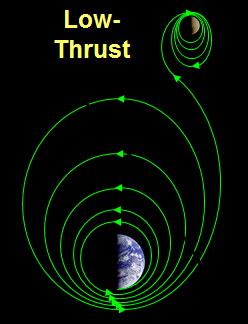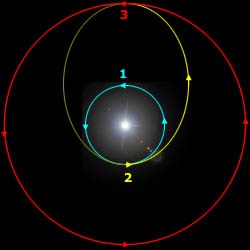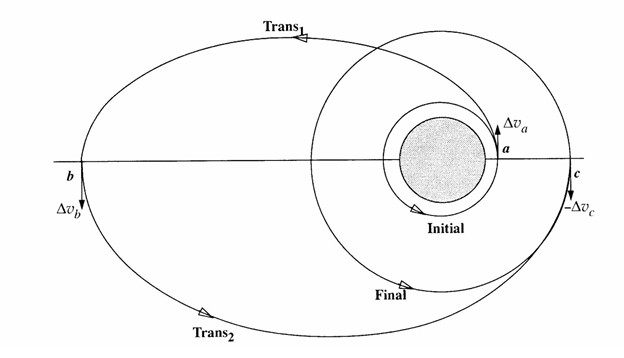Low-energy transfers are used when efficiency is paramount and fuel consumption is a heavily limiting factor. The basic principle of this kind of maneuver utilizes the basics of orbit modification and exploits that at peak efficiency. As stated previously, a momentary thrust will modify the exact opposite of an orbit most. This effect is magnified when changing the height of the orbit along its semi-major axis. Seen in the graphic to the left, the satellite makes small, prograde burns at the orbit's periapsis and, in turn, modifies the apoapsis. The time of thrust is so short so as to burn only when along that semi-major axis, and when changes made are most efficient. Low-energy orbits use very little fuel, but take far longer than a similar Hohmann transfer, or direct burn.

http://ccar.colorado.edu/asen5050/projects/projects_2012/wolma/img/transfers.png
A Hohmann maneuver is a series of burns used to change the height of a satellite's orbit. Shown in the image, going from Orbit 1 to Orbit 3 can be done by burning at some point until the apoapsis is at the height of the desired final orbit, Orbit 3. This second orbit will then be modified once the satellite is at the apoapsis. It burns prograde yet again, to this time raise its periapsis to match the desired height. For elliptical orbits, the initial burn is generally done at the original orbit's periapsis to maximize efficiency. This can also be done for orbits that aren't strictly aiming to increase in height. To lower the orbit, the satellite would burn retrograde until its periapsis was at the correct height, then correct that burn with another retrograde burn at the new apoapsis.

http://jwilson.coe.uga.edu/EMAT6680Fa05/Bacon/Nikki's%20Site/Hohmann_transfer_orbit.jpg
While Hohmann transfers are a very direct, efficient way of raising the total height of an orbit, it's not always the most preferred. In some instances, it's actually more efficient to raise the apoapsis way beyond the height of the final orbit, then do a small correction burn at that new apex. This may seem counter-intuitive but under certain conditions, it pays off. Being much farther out means that any thrust applied will have a greater effect on the orbit. for instance, at point b in the graphic, it requires much less fuel to increase the orbit's periapsis from point a to point c than it would to make the same burn at a lower height. While this does require more fuel to raise the apoapsis initially, that fuel discount at b can sometimes compensate such that the total fuel used is still less than a Hohmann transfer. When the final semi-major axis is more than 11.94 times greater than the initial semi-major axis, an intermediary height at point b can be chosen that allows for this maneuver to be advantageous.

http://ccar.colorado.edu/asen5050/projects/projects_2012/rhoades/index_files/image020.png